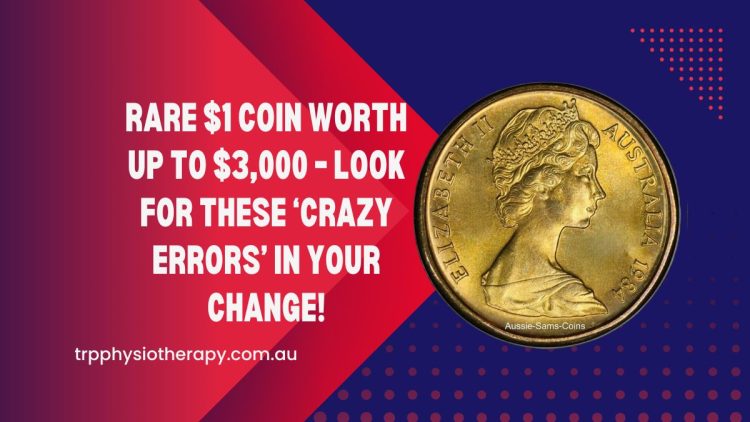Imagine finding a coin in your pocket that’s not just worth $1—but as much as $3,000. That’s the surprising truth behind a rare Australian $1 coin from 1984 that was accidentally struck on the wrong type of blank, creating a collector’s dream.
Only a handful of these error coins exist, making them one of the most exciting modern numismatic finds. Let’s break down what makes this coin so valuable, how to spot one, and what to do if you think you have it.
What’s the Deal with This Rare 1984 $1 Coin?
In 1984, Australia introduced the $1 coin to replace the paper banknote. Normally, these coins were made of aluminum bronze, giving them a distinctive golden color. But in a rare minting mishap, a few of these $1 coins were accidentally struck on 10-cent planchets.
This means the coin is not only lighter and smaller than it should be—it’s also silver-colored instead of gold.
These are known as “off-metal errors,” and they’re highly sought-after by collectors due to their rarity and uniqueness.
Key Features of the Rare Error Coin
| Feature | Standard 1984 $1 Coin | Error Coin (Struck on 10c Blank) |
|---|---|---|
| Metal Composition | Aluminum Bronze (Golden Color) | Copper-Nickel (Silver Color) |
| Weight | 9 grams | 5.66 grams |
| Diameter | 25 mm | 23.6 mm |
| Appearance | Gold | Silver |
| Error Type | None | Off-metal planchet (10c blank) |
| Mintage | Mass produced | Estimated 10–20 known |
| Auction Value | $1 (face value) | Up to $3,000 |
Why Is This Error So Rare?
The error occurred during the minting process when a 10-cent blank was mistakenly mixed in with $1 blanks. Since blanks are typically mass-shipped and loaded into minting machines in bulk, occasional mix-ups can happen—but they’re extremely rare.
The blanks are produced at overseas facilities and sent to the mint for coin production. Because of this complexity and quality control, only a tiny number of these errors ever make it into circulation—experts estimate that fewer than 20 such coins may exist.
How Much Is It Worth?
While one example of the coin sold recently for $1,500, another similar coin fetched $2,800 at auction. Prices vary depending on the coin’s condition and market demand, but the typical range is $2,000 to $3,000.
In some cases, collectors are willing to pay more due to the uniqueness of each error coin.
What Makes It Valuable?
- Scarcity – There may be only a dozen or so in existence.
- Visual Difference – Silver appearance immediately stands out from standard gold-toned coins.
- Collector Demand – Mint error coins are a niche but passionate area in numismatics.
- Auction Results – Recent sales have proven strong collector interest.
How to Check If You Have One
Think you might have this rare treasure in your change jar or old coin collection? Here’s how to check:
- Color – Look for silver-colored $1 coins.
- Size – A smaller-than-normal diameter is a key sign.
- Weight – Use a digital scale; if it weighs around 5.66 grams instead of 9 grams, it’s a strong contender.
- Incomplete Design – Since the $1 design was meant for a larger blank, some parts may be cut off or misaligned on the smaller planchet.
If you believe you have a match, it’s worth getting the coin authenticated and professionally appraised.
What Should You Do If You Find One?
If you suspect you’ve found one of these rare coins:
- Don’t Spend It! Store it safely in a protective case or holder.
- Avoid Cleaning It – Cleaning can reduce its value.
- Have It Evaluated – Contact a reputable coin grading service for verification and value appraisal.
- Consider Selling at Auction – Auction houses specializing in rare coins are the best place to get top dollar.
Other Rare Coin Finds Recently on the Market
This week’s auction that included the rare 1984 $1 error coin also featured:
- The iconic 1930 Penny
- Australia’s Holey Dollar
- Over 3,000 rare Australian and international coins
- A total collection value of over $2.5 million
This growing interest in rare coins means now is the perfect time to go through your old coins—you could be sitting on hidden wealth.
Errors like the 1984 $1 coin struck on a 10-cent blank are exciting reminders that mistakes can sometimes become treasures. If you enjoy collecting coins or are just curious about what might be lurking in your loose change, this is one coin you should absolutely look out for.
You never know—your next $1 coin could be worth thousands!
FAQs
How many of these rare $1 coins exist?
Experts estimate that between 10 to 20 coins with this specific error exist, making them extremely rare and valuable.
How much can I sell a 1984 error $1 coin for?
Depending on the coin’s condition and market demand, you can expect anywhere from $1,500 to $3,000, and potentially more at auction.
What if my $1 coin is silver, but it’s not from 1984?
Silver-colored $1 coins may exist for other reasons (e.g., plated or worn), but unless they match the weight, diameter, and error type, they may not be the valuable variety. Have it checked professionally to be sure.

